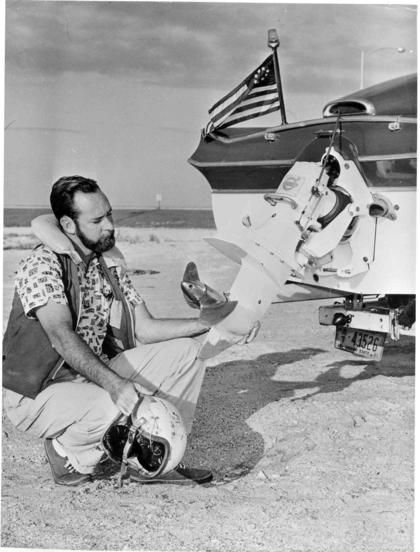The Quiet Innovators in Boating (Part 1)
- Richard Crowder

- Aug 31, 2022
- 7 min read
A previous series of mine on BoatBlurb was called Innovators in Boating, which focused on the people behind the boat brands and products with which almost all boaters would be familiar. This series will explore those people whose names you may never have heard about or if you have heard the name, may not be familiar with the role they played to advance boating technology and enjoyment. I will try to feature these quiet innovators in rough chronological order.
1) C. Raymond Hunt
Raymond Hunt arguably made the greatest advance in powerboat design that we enjoy and take for granted today. He was a natural tinkerer and sailor and not only a skilled racing helmsman mainly in New England but also took to designing many winning sailboats over the years. He also dabbled in all sorts of hull designs including larger Coast Guard vessels as well as tenders. He worked with Dick Fisher to design the original and iconic Boston Whaler 13, a design that carried forward for decades.
In the late 1940’s and into the 50's, he wanted to solve the problem of powered tenders for sailboats being slammed about in heavy seas. After much experimentation, he came up with a 23-foot powerboat with a transom deadrise of 24-degrees which he called a deep-V hull. On a particularly bad weather day with very rough seas during the America’s Cup Race off Newport, Rhode Island in 1958, Hunt’s tender sliced through the nasty water at speed.
2) Dick Bertram
Boatbuilder Dick Bertram happened to witness the phenomenon with Hunt's boat that fateful day, and was later taken for a ride by Hunt himself. Almost immediately he ordered a 31-foot version for his own use in Florida. Bertram had just graduated from Princeton and moved to Miami to open a yacht brokerage business. The result was one of the most famous powerboats ever built – the 31-foot, twin inboard engine boat featuring a full-length Deep-V hull design with a twenty-four degree deadrise at the transom, hard chines, and full-length running strakes.
Launched in 1959 and naming the wooden boat Moppie after his wife, Bertram, along with his partner Sam Griffith, entered it in the 1960 Miami-Nassau race which was described as having the worst sea conditions in its five year history. Bertram won by a large margin and set a new race record while most contestants didn’t even finish until the following day. Bertram was ecstatic. He used Moppie as a plug from which to mold his first fiberglass boat.
That boat became possibly one of the most iconic cruiser hulls of all time, the 1960 Bertram 31. In 1961, Bertram and Griffith repeated their Miami-Nassau race win in an identical fiberglass version called Glass Moppie. He displayed the Bertram 31 at the 1961 New York National Boat Show to great acclaim. The rest is history as the Bertram name became legendary and the company recently celebrated its 60th anniversary.
3) Jim Wynne
Born in 1929, Jim Wynne raced powerboats for fun in his school years, obtained a degree in mechanical engineering and a Masters degree in engineering from MIT. His first job was as Chief Test Engineer for Kiekhaefer Corp. of Fond du Lac, Wisconsin, makers of Mercury outboard motors. Wynne tested outboard motors in Wisconsin as well as at Mercury’s “secret” Florida test centre, Lake X. In 1958, Wynne crewed on the first outboard-powered Transatlantic crossing from Copenhagen to New York in a 22-foot Danish-built Coronet.
Along with Kiekhaefer engineer Charlie Strang, who, with Wynne had been experimenting with using a car engine inside the transom attached to the lower unit portion of an outboard motor on the outside of the transom. Together they approached Carl Kiekhaefer with the idea. Kiekhaefer was not particularly receptive as he saw the idea as cutting into sales of outboard motors.
Wynne resigned from Kiekhaefer (Mercury), refined his ideas in his garage, and then approached Volvo Penta in Sweden who immediately seized on the idea. They purchased the rights and introduced the Volvo Penta Aquamatic Sterndrive (Inboard-Outboard) at the 1959 New York Motor Boat Show to rave reviews. By 1962, there were 16 manufacturers of sterndrives, Kiekhaefer Corp. being one of them with its new MerCruiser sterndrive.
Wynne revived his love of boat racing, which culminated in being crowned World Offshore Champion in 1964 and 1966 while utilizing his sterndrive invention. He raced with some of the famous names of the time including Dick Bertram, Sam Griffith, Don Aronow, and Bill Wishnick. In 1965, he formed Wynne Marine, Inc. specializing in powerboat design of all types and sizes, commercial and pleasure. He is credited with designing the first production boat for Don Aronow, the first Formula including the 233 that Aronow raced to world acclaim, the first Magnum, and the first turbine-powered Thunderbird.
Wynne is behind the design of many of the family boats we all know and love. Until his premature death in 1990, he designed boats for over 30 manufacturers including Carver, Chris-Craft, Cobalt, Cruisers, Inc., Donzi, Grady-White, Hatteras, Larson, Stamas, and Trojan. It was at a dealer meeting for one of these manufacturers that I first met and had my only chat with Wynne. He was like a legend to me, very soft-spoken, and most obliging.
4) Fred Kiekhaefer
Marine industry innovator E. Carl Kiekhaefer, head of Kiekhaefer Marine and father of Mercury outboard motors, sold his company to the huge leisure industry giant Brunswick Corporation in 1961. Carl remained on as president until 1970. Shortly after leaving, Carl created Kiekhaefer Aeromarine concentrating on engines for the high performance and boat racing market.
When Carl died in 1983, Carl’s son Fred Kiekhaefer, an engineer and MBA graduate, purchased Kiekhaefer Aeromarine from his father’s estate and re-purposed the company from mainly high performance engines to a whole range of highly engineered and robust accessories for the rapidly expanding high performance and boat racing market.
The very robust and eventually industry standard Kiekhaefer K-Planes (trim tabs) that withstand the pounding of heavy seas along with Zero Effort controls for smoother, longer lasting, and stronger throttle and shift cables were early products of the company. In 1988, came the huge game-changer with the introduction of the beefy Kiekhaefer Surface Drive for race boats.
As offshore race engines were becoming more powerful, the surface-running outdrives then available simply could not handle the increased torque, power, and shock loading. Inboard-style but trimmable shaft drives were starting to appear to handle the increased loads. I remember arriving at an offshore race in 1988 and listening to the buzz in the pits talking excitedly about what everyone had heard – that a new outdrive was going to be race-tested that weekend. I remember watching as a superboat class V-bottom was wheeled into the launch ramp area with bags over the three outdrives. The boat was launched before the bags were removed.
The new Kiekhaefer drives were virtually flawless and were installed on the triple engine 46-foot Wellcraft Scarab Gentry Turbo Eagle driven by Don Johnson who ended up winning the World Offshore Superboat Championship that year. In 1989, these Kiekhaefer drives propelled Pete Markey to be crowned World Superboat Champion in his Little Caesar’s Pizza 46-foor Apache V-bottom. Two years in use and two consecutive World Offshore Championships in arguably the toughest of all categories. The Kiekhaefer drive immediately dominated the offshore racing circuit on catamarans as well as V-bottoms.
The following year in 1990, Mercury Marine purchased Kiekhaefer Aeromarine, and Fred became President of Mercury’s Performance Products Division. He soon changed the name to Mercury Racing as he says with a smile that enthusiasts would prefer to have the word “Racing” on their T-shirts. Fred spearheaded Mercury Racing to become the largest pleasure marine R&D centre in the world. The facilities, tucked away in separate premises in Fond du Lac, WI, the head office location of Mercury Marine, is intentionally hard to find unless you know where you are headed.
The facility has been expanded several times over the years and has been responsible, under Fred’s direction, for development and testing of most of the innovations that you have seen from Mercury Marine over the years. The beefing up of sterndrive legs producing the Bravo One, Bravo XR, Bravo II, and Bravo III with counter-rotation. The original cleaning up of two-stroke outboards to meet stringent environmental regulations resulted in the revolutionary OptiMax series, the development of direct injection FourStroke outboards right up to the latest 450R and then the very recent 600 horsepower V12 Verado are all products of the engine magicians at Mercury Racing.
Then think of sterndrive engine development, of the first change from carburetion to Electronic Fuel Injection (EFI), electronic ignition, followed by the horsepower increases with warranty included of 500, then 525, then Supercharged 600, 700, and 900 horsepower and culminating in the relatively recent 1100, 1350, and 1550 with dual electronic calibration fuel delivery and output depending on fuel octane used. Most recent is the incredible twin turbocharged 1650 horsepower 9-liter, four valve per cylinder, quad-camshaft V-8 which was conceived and developed entirely at Mercury Racing. Just to visit Mercury Racing as I have a couple of times is an eye-opener into the future of pleasure boating, even though all future products and developments are carefully covered and out of sight.
Why does all this high performance matter to the everyday family boater? It is the development and understanding of the stresses engines and drivetrains are put to that filter into the mainstream of family-oriented pleasure boating to make your leisure time boating more fun and hassle-free. You may have heard of VesselView and SmartCraft and Axius Joystick Piloting with Skyhook digital anchoring and autopilot as well as Digital Throttle and Shift (DTS). These are all products of Mercury Racing under the direction of Fred Kiekhaefer.
And in case you wondered, the Kiekhaefer Drive became the Mercury #6 Drive as the latest in its lineup after the Speedmaster #5 Drive. Mercury Racing continued to improve the #6 and created the #6 Dry Sump Drive and most recently the M8 Drive. But after 22 years, Fred Kiekhaefer retired from Mercury Marine in 2012 at age 65 and has set up K.Lab Design Works, his own engineering think tank and consulting company near his home in Colorado. For those 22 years, the Kiekhaefer name has not appeared on any products, but the influence of Fred Kiekhaefer on the development of new and sometimes revolutionary pleasure boating products is extraordinary.
























Comments